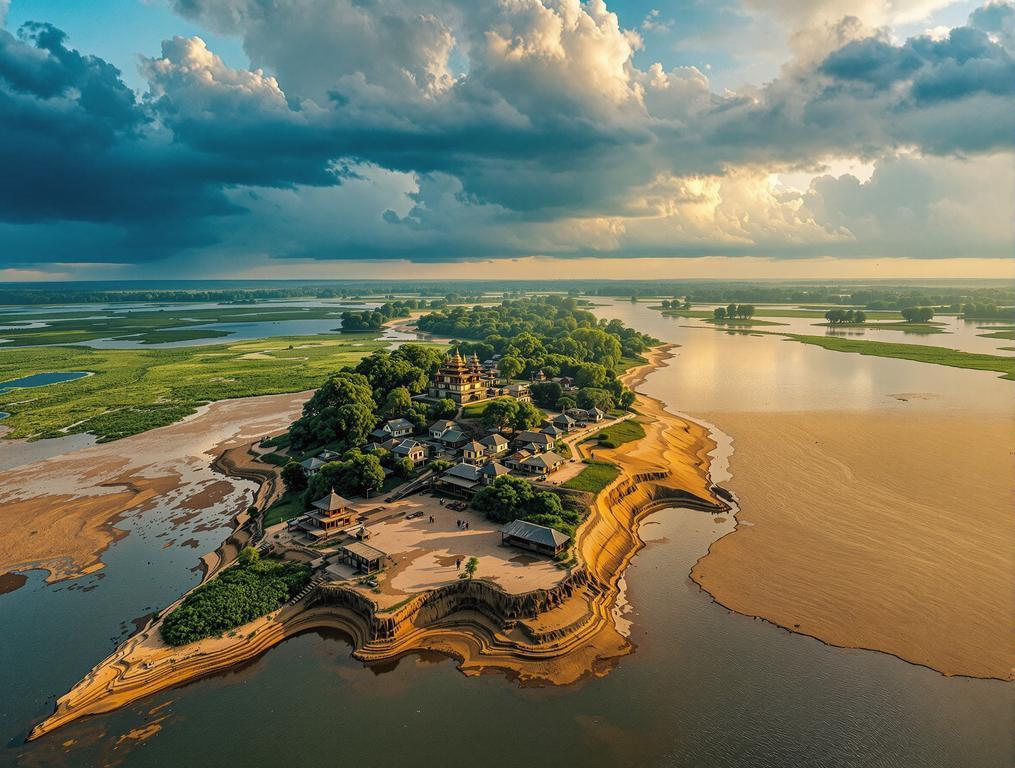The water slaps against our ferry as it navigates the mighty Brahmaputra River. I’m en route to Majuli, the world’s largest river island that’s fighting a desperate battle against time. Home to 150,000 residents, this remarkable island has already lost 370 square kilometers to erosion – shrinking from 1,250 to just 880 square kilometers. My local guide points toward the shoreline, where bamboo stilts prop houses above the encroaching water. “By 2030, much of this may be gone,” he says quietly.
The vanishing world of Majuli: Where land disappears by 7.4 square kilometers annually
Standing on Majuli’s shores, I’m witnessing climate change in real-time. The Brahmaputra River doesn’t just flow around this island – it actively consumes it. Scientific studies confirm that Majuli loses approximately 7.4 square kilometers annually to erosion, with monsoon floods accelerating the destruction.
What makes this environmental crisis uniquely heartbreaking is what’s at stake culturally. Majuli houses 22 ancient Satras (Vaishnavite monasteries), some dating back to the 15th century. These living cultural institutions are simultaneously pursuing UNESCO World Heritage status while fighting to avoid being washed away entirely.
I visit Kamalabari Satra, where monks demonstrate traditional mask-making techniques passed down through generations. Each ceremonial mask requires over 100 hours of meticulous craftsmanship, using bamboo, cotton cloth, and clay sourced from the very riverbanks that threaten their existence.
“We are caught between two timelines,” explains a senior monk. “Our UNESCO application moves slowly while the river moves quickly.” The irony isn’t lost on me – global recognition may come too late for many of these cultural treasures.
Beyond tourism: Witnessing a living culture in peril
Unlike this Greek island that preserves authentic experiences without imminent threat, Majuli’s cultural treasures face extinction within a generation. The island’s predominantly Mishing tribal population maintains traditions despite knowing their homeland is disappearing beneath them.
At Salmora village, I watch potters creating distinctive black earthenware without wheels – shaping clay entirely by hand according to centuries-old techniques. Nearby, women weave intricate Mekhla Chadars (traditional Assamese garments) on back-strap looms, incorporating patterns that tell tribal stories.
“We don’t just make pottery – we’re making memories that our grandchildren may only know through photographs. The clay from our riverbanks holds our ancestors’ knowledge.”
Beyond cultural heritage, Majuli hosts migrating birds similar to the Falkland Islands’ remarkable wildlife sanctuary, with over 186 species visiting annually. The wetland ecosystem provides critical habitat for endangered birds like the Greater Adjutant stork, adding ecological urgency to preservation efforts.
Other endangered communities like this tiny town that created an economic revival have shown how preservation efforts can attract support and investment. But Majuli faces a fundamental challenge – can you preserve what nature is actively reclaiming?
What the guidebooks won’t tell you about visiting during monsoon
Most visitors avoid Majuli during monsoon season (June-September), but this period offers a raw, authentic experience. The two daily ferries from Jorhat’s Nimati Ghat still operate, though service can be unpredictable. Travel early – the 6 AM ferry avoids afternoon river turbulence.
For accommodation, skip the tourist lodges and stay at Mishing tribal homestays built on bamboo stilts that adapt to rising water levels. A night costs approximately ₹1,500 ($18) including home-cooked meals featuring traditional Mishing dishes like fish wrapped in banana leaves.
Majuli could benefit from sustainable tourism models like this Maine town that maintained its authenticity while supporting preservation efforts. Currently, limited tourism infrastructure means visitors can experience genuine cultural immersion without commercial distractions.
Just as ancient land bridges once connected continents, Majuli’s existence represents a fragile connection between past and present Assamese culture. The difference is that we’re watching this connection dissolve in real time. As I board the ferry back to mainland Assam, I can’t help but wonder if my daughter Emma will ever have the chance to experience this remarkable island – or if it will exist only in travel archives and cultural memory. The mokoli pohar (evening sun) casts long shadows across the water, a fitting metaphor for Majuli’s uncertain future.
